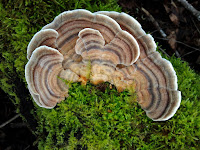Now that our first real cold snap of the season has come and gone, it's time to ruminate about hot summer days! One of my favorite hiking and photography places within an hour's drive from home is the Columbia River Gorge Scenic Area. Although I seldom visit the Gorge in cold weather, it has a unique beauty all year. If you've lived here for any length of time, chances are good that you have hiked a few of the waterfall trails and/or taken visitors on a tour of the old scenic highway. And with 80 miles of river and hundreds of trail miles to explore, you won't run out of destinations.
 From a botanical point of view there are several unique and interesting places to land for a fun and rewarding day trip. In summer, my favorite mini-destination is the venerable Oneonta Gorge. It's basically a half mile long slot canyon that runs due south from the Columbia River on the Oregon side. It's narrow, deep, and a cool water creek runs through it. In addition, it can be a beautiful photography site - if you manage to get there when no other humans are around. And like many places in the Columbia Gorge itself, it is being loved to death, so to speak.
From a botanical point of view there are several unique and interesting places to land for a fun and rewarding day trip. In summer, my favorite mini-destination is the venerable Oneonta Gorge. It's basically a half mile long slot canyon that runs due south from the Columbia River on the Oregon side. It's narrow, deep, and a cool water creek runs through it. In addition, it can be a beautiful photography site - if you manage to get there when no other humans are around. And like many places in the Columbia Gorge itself, it is being loved to death, so to speak.
 But I'll be the first to admit, trekking into the Oneonta Gorge on a sweltering August day is nothing short of bliss. The combination of the narrow 300 foot high basalt walls and cool ankle deep water of Oneonta Creek drops the 90 plus highway temperature at least 15 degrees. The real challenge and fun is to reach the end of this mini-gorge where you can swim in a deep pool below a 100 foot waterfall. But to reach it, you have to scale a huge log jam, walk a 1/2 mile in the creek, and wade through a deep spot that can reach your neck. On a hot summer day, this becomes almost like a pilgrimage along with your fellow travelers; the mood is upbeat and festive. People bring their dogs, kids, and food.
But I'll be the first to admit, trekking into the Oneonta Gorge on a sweltering August day is nothing short of bliss. The combination of the narrow 300 foot high basalt walls and cool ankle deep water of Oneonta Creek drops the 90 plus highway temperature at least 15 degrees. The real challenge and fun is to reach the end of this mini-gorge where you can swim in a deep pool below a 100 foot waterfall. But to reach it, you have to scale a huge log jam, walk a 1/2 mile in the creek, and wade through a deep spot that can reach your neck. On a hot summer day, this becomes almost like a pilgrimage along with your fellow travelers; the mood is upbeat and festive. People bring their dogs, kids, and food.In spite of the hoopla, Oneonta Gorge remains a botanical marvel. Outside of July and August, few people venture into this unique spot. Oneonta Creek runs crystal clear and supports a variety of small fish, frogs, salamanders, and snakes. The basalt walls along the entire half mile are literally covered with moss and are teeming with ferns, woodland plants, and lichens.
 For waterfall lovers, the Oneonta Creek trail takes you to three of the four waterfalls along the creek. The Lower Falls shown here is the fourth one and is visible only by walking through the Oneonta Gorge. We have made the loop trail in the summer many times, topping it off with the cool walk into this slot canyon. These trails are well documented by most Gorge hiking websites and guidebooks.
For waterfall lovers, the Oneonta Creek trail takes you to three of the four waterfalls along the creek. The Lower Falls shown here is the fourth one and is visible only by walking through the Oneonta Gorge. We have made the loop trail in the summer many times, topping it off with the cool walk into this slot canyon. These trails are well documented by most Gorge hiking websites and guidebooks. |
| As the human visitors parade by, this Pacific Giant Salamander (Dicamptodon tenebrosus) watches calmly from his little cave. |
To close out this post, here's a look at the current conditions in this spot. We visited several places along the old scenic highway on January 8th. Earlier in the week, snow and below freezing weather made its way in. We look forward to spring!




























